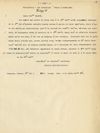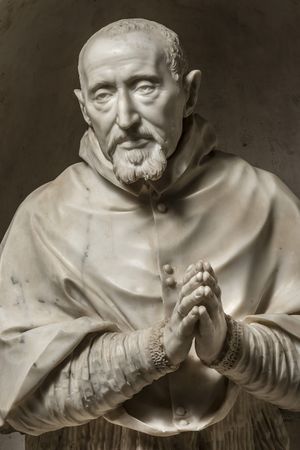Monumenta Bellarmini
The Monumenta Bellarmini is proposed as a space to bring together the selection of the unpublished works by Robert Bellarmine inside the APUG, as well as his letters and instructions dating back to his cardinalate.
The collection Epistolae Bellarmini Cardinalis is a collection of letters written by Cardinal Robert Bellarmine, or addressed to him, between 1599 (beginning of his cardinalate) and 1621, the year of his death. The collection was started by Xavier-Marie Le Bachelet SJ (1855-1925), then increased by Sebastiaan Peter Cornelis Tromp SJ (1889-1975) and, in the final phase, integrated by other Jesuits, including Gustavo Galeota SJ.
The first objective of Monumenta Bellarmini is to make available this huge collection so far consulted only on an ad hoc and limited basis.
See also University of Saint Mary of the Lake. Bellarmine Letters
| Epistolae Bellarmini Cardinalis | Works | Bibliographia Bellarminiana |
|---|---|---|
| Explore | Explore | Explore |
Monumenta Bellarmini: the (invisible) unity of the difference
In other words, "the Christian heresy" is a special subject of the very first importance to the comprehension of European history, because, in company with Christian orthodoxy, it is the constant accompaniment and agent of European life. Heresy is the dislocation of some complete and self-supporting scheme by the introduction of a novel denial of some essential part therein. We mean by "a complete and self-supporting scheme" any system of affirmation in physics or mathematics or philosophy or what-not, the various parts of which are coherent and sustain each other.
H. Belloc, The Great Heresies, Sheed & Ward, New York, 1938
The 17th century presents significant rises of complexity, which have been preparing the future socio-cultural developments of the society. Here complexity refers to the increasing difficulty to report items within a system. This increase in complexity, through enhancing the possibilities that may be implemented, will force selection and choice, which involve trying to contain or reduce the contingency, but, at the same time, helping to create it. The complexity is not in things, but in the form of observation.
One goal of this project is discovering the latency of Monumenta Bellarmini, conceived as a documentary observation of the society from which it was produced. The identification of these historical a priori might help to achieve the description of changes of what Michel Foucault used to call General grammar. Bellarmine's production would help to identify the distinctions which were operated with the aim to establish the episteme of early modernity, understood as a set of discourses, institutions, laws, rules, philosophical and scientific statements. Ultimately, a network of provisions or conditions of possibilities that generated new discursive and taxonomic practices.
The Disputationes de controversiis Christianae fidei adversus hujus temporis haereticos (Ingolstadt, D. Sartorius, 1586-1593) is considered one of Bellarmine's fundamental works. This treatise enrolled in what is called controversial theology, which presents a complex layering over time: the pre-Tridentine phase marked by the controversy around the loci communes (Melanchthon, Loci communes rerum theologicarum seu hypotyposes teologicae [Wittenberg, 1521]); Johannes Eck, Enchiridion locorum communium adversus Lutherum et alias hostes ecclesiae [Landshut 1525]), the abundant sources generated from the Council of Trent, the De locis theologicis libri XII by Melchior Cano (Salamanca, 1573) and so on.
The Catholic and Protestant historiographies, in turn, actively participating in these "wars of truth"[1], have been producing an auto-generated complexity from the discipline itself, thus establishing an exponential increase of controversiality gradients. This complexity becomes elusive for conscience and historical analysis is likely to get lost in the details. Besides this documentary monumentality, there is also the Robert Bellarmine's biographical reconstruction (XVII-XX), which has often been conceived in controversy.
Faced with such a stratification, anyone wishing to build knowledge starting from a causal network of events to be included in a coherent and plausible narration, would probably start a one-way trip.
Our research proposal does not intend to wonder what truth (dogma) or error (heresy) are, but which differentiations made it possible attributing a value of error or truth to certain assertions. How did this difference arise and how did it move through time? How come some historiographical systems have been observing Robert Bellarmine in a certain way while others did it in a different way?
Some documents of the Monumenta Bellarmini may be an opportunity to describe the evolution of religious (Christian) communication in early modernity. What is called heresy is a variation that allows to recognize a particular communicative selection that is designated as “ecclesiastical orthodoxy”. To that effect, the heretical against-communications led to new selections and then to further stabilization, invigorating the identity construction. This process resulted in an increasing hierarchisation of the Church, as well as an increase of sacramentalization and dogmatization.
Some envisaged research lines to study the Monumenta Bellarmini are as follows:
- History of the collection Epistolae Bellarmini Cardinalis, in particular by identifying the distinctions from which such a set is considered, at a given time, to be a plausible tool for historiographical research, intended for publication and eventually left in the dark of an archive.
- Precisely, the 17th century represents the transition from mistrust of the innovation to its appreciation. Through observing the latency of the Bellarmine's documentation, produced by a system characterized by increasing acceleration of innovations, the aim is to identify the distinctions that religious communications used to face the novitas concept and to try to contain the pressure due to the increase of the possibilities of change inside the system. This will involve an analysis of new observations that are produced with respect to the semantics of temporalization. To that effect, it might be interesting to compare the innovations that John Dryden (1644) introduced into an ancient text like Oedipus to meet the expectations of a public that was not interested in the repeated narrative anymore. See in this regard the letter of Antonio Albergati (1566-1634), papal nuncio in Cologne, to Robert Bellarmine.
- Bellarmine's correspondence contains numerous references to the book market as a whole. In this regard, we intend to describe the relationships between book market, censorship (both political and religious) and reading; these three interconnected aspects of modern society are rarely investigated from the perspective of the social system that generated them.
- Through the preparation of a Bibliographia Bellarminiana, we intend to study the historical construction of Robert Bellarmine. This study will be carried out starting from several observations on his figure published over four centuries.
These lines of research will be implemented by working on the platform Gregorian Archives Texts Editing (GATE), a work and study collaborative place where all interested researchers can contribute by participating in the transcription and annotation of documents or commenting and discussing individual aspects of the project. To request an account and start the collaboration, please visit this link.
Copyrights
Unless otherwise indicated, all files and contributions (transcriptions, pages, comments) uploaded and submitted to GATE by administrators and users are considered to be released under the Creative Commons Attribution-NonCommercial-NoDerivatives 4.0 International License. All the rights on the images of the manuscripts or other documentation are property of the Historical Archives of the Pontifical Gregorian University (User:ArchivesPUG). If you need high resolution images for your publications or for other usages, please contact us using this form.Your contributions to GATE must be original or, at most, copied from public domain or similar free sources. Remember to always cite your sources and, more important, do not submit copyrighted work without permission.
Report any abuses to the project administrators, using this form.
Acknowledgements
We would like to thank Daniel Benvenuti for his help in digitizing the Epistolae Bellarmini Cardinalis collection and Jan Machielsen, who provided many EBC letters with metadata and remarks about sources and authors (look also here for a news about his valuable contribution).
References
- ↑ This concept is used by John Milton in Areopagitica: A speech of Mr John Milton for the liberty of unlicensed printing to the Parliament of England (1644): “When a man hath bin labouring the hardest labour in the deep mines of knowledge, hath furnisht out his findings in all their equipage, drawn forth his reasons as it were a battell raung'd, scatter'd and defeated all objections in his way, calls out his adversary into the plain, offers him the advantage of wind and sun, if he please; only that he may try the matter by dint of argument, for his opponents then to sculk, to lay ambushments, to keep a narrow bridge of licencing where the challenger should passe, though it be valour anough in souldiership, is but weaknes and cowardice in the wars of Truth.” Also see Baker, H. The wars of truth, Harvard University Press, 1952.



